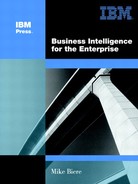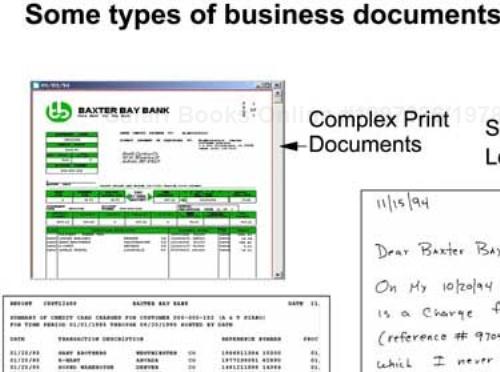Beyond the realm of information held in traditional databases lies the world of unstructured data. The information we deal with comes in these forms, among others:
Notes
E-mails
Faxes
Word processing
Spreadsheets
Images and other graphics
Invoices and other hard-copy output
Web pages
Audio
Video
We all have been involved in dealing with various portals and end-user interfaces to this critical volume of information. We may see an article regarding a competitor who has had some success, such as an increase in market share, a new product, and so on. Up goes the warning flag, and we try to ferret out more information from our competitive database—oops, we don't have one!
A search of several sources that publish unstructured information statistics yielded the following interesting metrics:
The average document is copied, either physically or electronically, nine to eleven times at a cost of about $18.
Documents cost about $20 to file physically (25 percent of the cost is the walk backward and forward between the archive).
Retrieving a misfiled document costs about $120—3 to 5 percent of a company's document has disappeared or is misfiled.
The cost of a “dial back” call is four times the cost of a finalized call in one single telephone dialogue.
Knowledge workers waste 20 to 30 percent of their working hours managing document-based information.
Whether these figures are painfully accurate is not the point. There are many studies and points of view regarding the volume of unstructured data and how to grapple with it. Quite often, this data contains significant business facts—if you can find them. Then there is always the problem of finding the article, fax, or e-mail again. You vaguely remember getting a note from someone awhile back, but it wasn't important at the time.
One requirement for those who work with unstructured data and software to manage it is, “If it isn't digitized, it doesn't exist.” Hence, we tend to hear more about ECM (Electronic Content Management) where the digital forms of data are made accessible, searchable, and connectable with software and processes. What they mean is that electronic searches and software can find information in context and on demand exponentially faster than performing the same activity manually. There are many forms and formats of business documentation. A few are illustrated in Figure 5-1.
Workflow and coordination of documents and processes are some of the valuable by-products of most unstructured content solutions. Our discussion on CPM solutions also suggested that workflow is key to creating a synergistic BI environment. Very few BI objects are created just for a single person's usage. Most BI objects (reports, charts, and so on) are created for groups of individuals, and many are used by several levels within an organization.
Content management solutions often yield unanticipated results, as the recipient may receive information that arrives at a time when the current context of the information is relevant to a business problem or the situation has changed. It wasn't important yesterday, but today an entirely new set of circumstances exists.
The following industries and associated areas have been affected and positively influenced by CM solutions:
Financial
Loan origination
Signature verification
Contract management
Investment research
Mutual fund processing
Credit card applications
Letter of credit
Customer service
Tax records
Leasing transactions
Stock investments
Overall records management
Government and transportation
Law enforcement (case records)
Land records
Asset management
Tax processing
Way bills
Air bills
Records management
Manufacturing
Material safety data sheets
Clinical research
Research and development records management
Technical manuals
Regulatory compliance
Contract management
ISO 9000 certification
Asset management
Engineering change control
Insurance and health
Claims processing
Patient records
New drug administration
Patient accounting
Policy origination
Group pension benefits
Underwriting
Policy administration
Cross-industry
E-mail archive
Order processing
Customer service
Sales force automation
Litigation support
Competitive files
Correspondence tracking
Human resources
Employee applications/benefits records
Why are your peers and competitors keen on ECM today? Some key factors driving these solutions include the following:
Business continuity is a recognized issue, and while companies have a handle on data, they often don't have a handle on the 85 percent of their information that is content.
Complete e-business enablement is difficult without content; a true connection with back office processes is required to become an on-demand company.
Solid business fundamentals are back in executive's minds; ECM delivers the basics—productivity and cost control, customer service enhancements, process and records control, reuse of existing assets.
If you pause to think about non-digital content, one thing that should leap out immediately is that it is mostly single-thread. Few hard-copy documents can be read by several individuals at the same time unless you have a very large cubicle. Some of the difficulties often cited by the ECM literati include the following:
Paper overwhelms the workspace.
There is no concurrent access; only one user at a time can access the document.
Documents are easy to lose or misfile.
Security is poor.
It's hard to find a folder or document when needed.
It's hard to find digital assets to reuse them.
Video and audio don't fit in a folder.
A workstation's footprint is not enough to hold large video or voice files.
There is no table of contents for folders.
Users can't use an automated search.
Costs to manage and distribute paper files are rising.
PC files are stored in disparate servers; copies are made and filed.
Documents are not immediately available, which leads to poor customer service.
Workflow means “pick up and move the folder.”
There is no cross-enterprise folder of your entire customer relationship.
If it's not electronic, you can't access it over web, which means you can't do e-business.
You need the ability to repurpose content (for web publishing and so on).
You need a common infrastructure for ECM (so you can develop specific clients).
If we add the known difficulties with organizing our structured data to this list, we may be tempted to just sit back, sigh, and work on our virtual golf swing. It doesn't have to be a hopeless chase and endless cycle of frustration. Take a moment to scan Chapter 9, which is on Corporate Performance Management (CPM), and think about the needs within your organization. If you establish a workflow-based approach to information, the fact that it is structured or unstructured will not matter. The point is to establish loops and processes and to set your employees on a course that effectively uses this set of processes and tools.
Figure 5-2 identifies a few inputs that may relate to a customer and the associated information that you may create and use with their data. They place an order, you cut an invoice, they pay (maybe), you analyze and report based on this information. What if you receive a letter from an irate customer about a product and/or poor service, and he asks for a refund? Yes, you can back out the information and make adjustments, but what if you have an underlying surge of such incidents and you aren't tracking them well…if at all?
It is important to treat all customer touch points as data and to ensure that there is a means to effectively capture, measure, and act upon all of them. Customer loyalty is a rare commodity today, but loyal customers are out there. Many customer satisfaction issues remain hidden in some of the departments that deal with them directly. The lack of end-to-end processes and feedback loops ensures that this unacceptable situation persists.
Most RDBMSs (relational database management systems) support several extended forms of unstructured data. However, storage and retrieval alone isn't the answer. Why not? Here are some reasons:
Content should be indexed as a corporate asset, but it should reside as close to the user as possible because of its impact on the network (distributed departmental use). This concept is foreign to relational databases.
Content must follow life cycle procedures, which may place the content in special storage devices (optical and/or tape) and at times in media devices that are not online.
Delivery of content can be very specific (streaming techniques for video and audio) at times, or content conversion may be required based on the application requirements.
LOB integration requires an easier, higher-level API set than SQL.
Security must be implemented based on content type rather than databases and tables.
Searches (SQL queries) that are CPU intensive must be separated from retrievals that are IO intensive.
ECM experts often recommend a walk-through to see if all the pertinent steps and processes being utilized today can be simplified, condensed, expedited, and generally made more efficient. An ECM walk-through and CPM models have lots in common. Critical steps and critical information are identified, as is the flow within the enterprise. Roadblocks and inefficiencies often leap out, and creative new processes may be used to address them.
Some data collected in an ECM walk-through found to be valuable in customer studies includes the following:
Number of people in each area
Number of work steps
Number of documents
Time to do a task
Time to retrieve a file
Time to do call backs
Time to find a document in a folder
You should also ask customers the following questions:
What causes you delays?
How much time could you save if...?
How much would your productivity improve if...?
A final note: If you engage in ECM solution development, be sure that the vendor presents a customized and proprietary solution just for you. You've identified what needs to be done to change your business step by step. Make sure that the steps can be technically done and done in real time. Remember, anything runs well on an overhead projector, and unless the bulb burns out, it does not fail.


